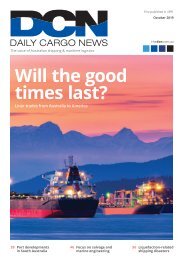DCN0718_Combined_150
You also want an ePaper? Increase the reach of your titles
YUMPU automatically turns print PDFs into web optimized ePapers that Google loves.
AUD/USD<br />
Australian dollar/U.S. dollar, 1D, FXCM<br />
Vol (20)<br />
Published on TradingView.com, June 12, 2018 19:19 EST<br />
FX:AUD, ID 0.75731 s +0.00049 (+0.06%) O:0.75682 H:0.75768 L:0.75676 C:0.75731<br />
Nov 17 Dec 17 Jan 18 Feb 18 Mar 18 Apr 18 May 18 Jun 18<br />
AUD/EUR<br />
Published on TradingView.com, June 12, 2018 19:8 EST<br />
FX_IDC:AUDEUR, ID 0.6444 t -0.0003 (+0.05%) O:0.6449 H:0.6449 L:0.6444 C:0.6444<br />
Australian dollar/euro, 1D, FXCM<br />
Vol (20)<br />
Nov 17 Dec 17 Jan 18 Feb 18 Mar 18 Apr 18 May 18 Jun 18<br />
0.81000<br />
0.80000<br />
0.79000<br />
0.78000<br />
0.77000<br />
0.76000<br />
0.75000<br />
0.74000<br />
0.73487<br />
0.73000<br />
0.6700<br />
0.6650<br />
0.6600<br />
0.6550<br />
0.6500<br />
0.6000<br />
0.6400<br />
0.6349 0.6350<br />
0.6300<br />
0.6400<br />
0.6200<br />
0.6<strong>150</strong><br />
depressed global growth. This has<br />
continued for 10 years in the ECB,<br />
Bank of Japan, RBA and RBNZ. As their<br />
economies continue to struggle to get<br />
on top of deficit/debt levels and stunted<br />
growth they have maintained extremely<br />
accommodating monetary policies. The<br />
US, in contrast, has boomed recently<br />
and is rapidly returning to a normalised<br />
monetary policy. This has been reflected<br />
in inflation, growth and employment<br />
leading to rising interest rates. The Fed<br />
has been raising rates over the last two<br />
years and look set to continue to do so.<br />
They operate on an island. US growth<br />
has pushed interest rates up, as demand<br />
surges, while a reasonable return on<br />
money promotes competition for the<br />
investment dollar. Normalised monetary<br />
policy is a place where all economies<br />
wish to be, but indebtedness, sluggish<br />
growth and instability remain a curse to<br />
other western economies. Rising interest<br />
rates support a stronger currency so<br />
expect the US dollar to appreciate over<br />
most currencies in the coming year.<br />
Therefore, recent currency<br />
fluctuations are rather exaggerated when<br />
measured against the USD, as opposed<br />
to the EUR. e.g. the trading range of the<br />
AUD/USD this year has been 0.7430-<br />
0.8130 (700 points or a 9.5% fluctuation)<br />
while the AUD/EUR has moved from<br />
0.6200-0.6550 (350 points or a 5.5%<br />
fluctuation). This continues to hold true<br />
as the EUR moves more in line with<br />
the AUD, versus the reserve USD (N.B.<br />
their respective central banks occupy<br />
a similar space in dramatic contrast<br />
to the Federal Reserve). It is therefore<br />
even more important for businesses<br />
to address foreign currency risk and<br />
ensure it is managed effectively. The risk<br />
factors and protection against exchange<br />
rate movements are essential. Foreign<br />
exchange cover should, therefore, be<br />
even more comprehensive for the USD<br />
as fluctuations are more likely to be<br />
even greater. Take the risk out of foreign<br />
exchange exposure.<br />
CENTRAL BANK INFLUENCE ON<br />
THE MARKETS<br />
Central bank influence has been more<br />
dominant in markets since the GFC.<br />
The GFC encouraged record-breaking,<br />
expansive monetary policy to combat<br />
massive debt levels and stimulate<br />
SUMMARY<br />
Markets operate on confidence and<br />
removing geo-political obstacles provides<br />
a conducive environment in which<br />
to operate. The focus then shifts to<br />
global economic data and the health<br />
of the individual countries economy<br />
and fiscal/monetary policy. Monetary<br />
policy has dominated interest rates, thus<br />
currencies, forcing effective management<br />
of foreign exchange risk. Financial<br />
tools can remove this risk and allow<br />
the orderly function of a business in an<br />
international environment. Risks in the<br />
near future, remain the trade wars and<br />
unforeseen geo-political events while<br />
global economies improve.<br />
thedcn.com.au July 2018<br />
53

















